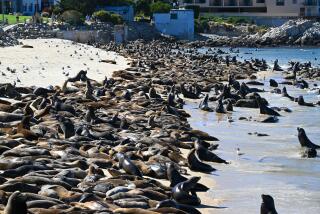Swallows, Crowds Back
- Share via
Binoculars, zoom lenses and even a telescope or two in tow, flocks of tourists converged on Mission San Juan Capistrano on Wednesday and craned their necks to glimpse the return of Orange County’s most famous birds--the swallows.
They had to look hard, but there they were: High above the palm trees that shade the mission grounds, above circling squadrons of ordinary pigeons, dozens of the small birds, distinguished by their tapered wings and bat-like flight, flitted about to the delight of those stuck on the ground.
‘We Saw Them!’
“Yes! We saw them,” said Johnny Garcia, a cocktail bar pianist from Lakewood. “This is such an important occasion--we try to come every year. Actually, we were going to go to Vegas this week, but you can see the same old thing in Vegas anytime. This day here is special.”
The swallows officially ended their 6,000-mile journey from Goya, Argentina, at 8:33 a.m. on March 19, St. Joseph’s Day. Decades ago, mission priests chose the Roman Catholic holiday as the official day to celebrate the appearance of the swallows, which return to nest in the eaves of the mission’s ruins each March.
As he has done for the past 39 years, San Juan Capistrano patriarch Paul Arbiso, 90, sporting a bright red cummerbund, clanged out the birds’ arrival on the mission’s ancient bells.
The colorful, white-bellied little birds will repair their old mud nests and breed here before they head south again in October.
About 2,000 tourists were milling around the mission’s stone paths and fountains by mid-morning, and more than 4,000 were expected to pass through the gates by the end of the day, said Dick Landy, director of tourism for the mission.
Some morning visitors had to wait in line for half an hour, but most said it was worth it once they got in. “I used to read about this in the papers in England,” said Alison Stevens, 32, a native Londoner now living in Mission Viejo. “This is the first time I’ve come to see the swallows. It’s really very attractive.”
Flying High
Maria Alcala, 65, of Caracas, Venezuela, said the golondrinas were “darling,” even though she had not yet seen one because the swallows were “too high up in the sky.”
On hand to sing the song that made the swallows and San Juan Capistrano famous was Rafael (Googie) Rene, whose father, Leon, wrote “When the Swallows Come Back to Capistrano” in 1939.
Earlier, Rene answered phone calls (“Hello, this is Mission Control”) from radio stations around the country inquiring whether the swallows had actually arrived and whether it was true that there were fewer birds this year.
‘Great Happening’
“They’re here, but I haven’t talked to the birds, I don’t know if Joe Swallow brought his family this year,” he said. “Who cares about statistics. It’s a great happening.”
In a quiet nook of the mission, a television reporter swept her hair out of her face and said for the umpteenth time into the camera, “The swallows have arrived in San Juan Capistrano, but because of the growth this town has undergone in the past few years, many of them are seeking a more suburban setting to rest their wings for the summer.”
“Did you hear that?” an onlooker remarked. “We’ve come to the wrong place.”
Sacramento resident Kathleen Toscano said she came to see the swallows after she heard a radio announcer making jokes about their arrival. “It’s a lot like watching the whales,” she said. “You wait for a couple of hours to see something, and then you finally see them far off. But it’s a real pleasure just to be in a place like the mission. And I did see about a dozen swallows.”
More to Read
Sign up for Essential California
The most important California stories and recommendations in your inbox every morning.
You may occasionally receive promotional content from the Los Angeles Times.













